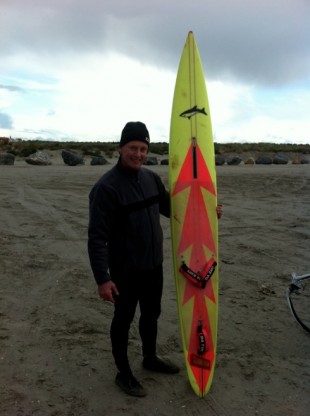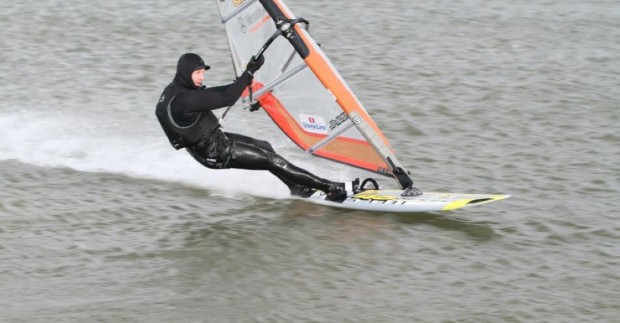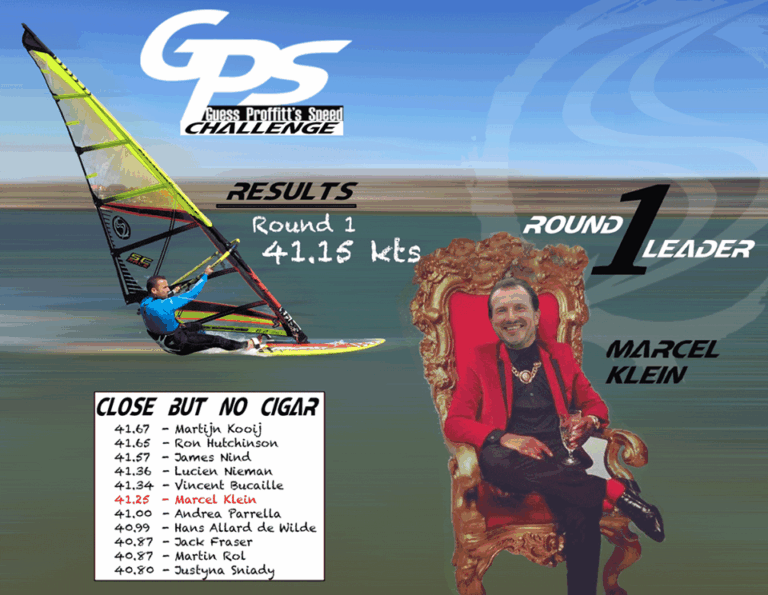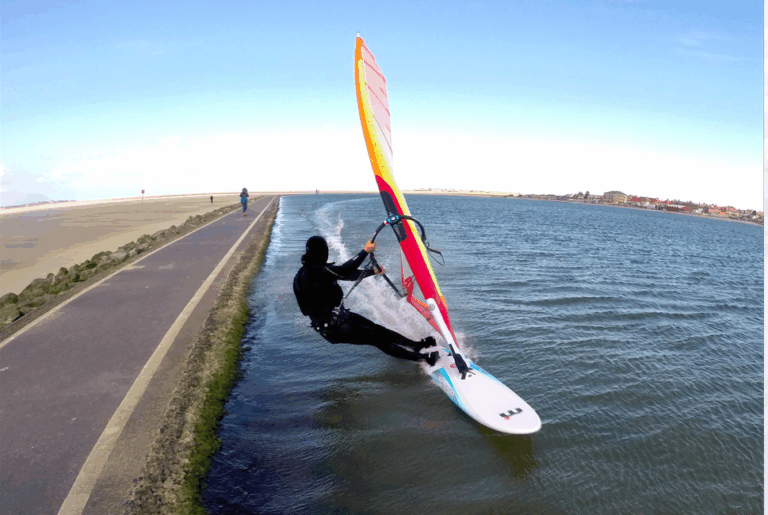Feeling the need for speed? It’s time to get tooled up with Oisin van Gelderen and his guide to all the equipment and know how you need to become a successful speedsailor….

So, with Luderitz already underway, and Weymouth Speed Week starting this weekend, it’s time look a little closer at getting set up with the right gear for going super-fast, and getting yourself towards (and hopefully over) that 40 knot barrier.
My one piece of advice, above all else is: KEEP IT SIMPLE. Yes, a lot of speedsailors have a worrying fin-fetish, and love talking about all the numbers and techie stuff, but don’t let that put you off. Speedsailing is about as simple as it can get. Find very flat water – with as much wind as possible (over 25 knots, ideally 30+) blowing down it – sheet in and hang on, and enjoy the ride until you run out of water. Then check your GPS, and go and do it all over again. If you are interested in going out in ‘proper’ speed conditions, then you can easily get away with one board, one fin and one sail, as long as you spend your time looking for the right conditions to use them.
Really – a huge part of the art of going fast, is actually figuring out when and where to sail. Other days may be good training, but when it comes to pushing your personal best, the conditions you choose to sail in will have as much effect on your top speed, as the gear you are actually going to use.
Oisin and Noelle Doran setting some Irish speed sailing records…
But again let’s look at the ‘ideal conditions’ – a speed board for sailing on a speed course in 30+ knots…
GPS First and foremost, you will definitely need to invest in one of these to see how fast you are actually going. It really doesn’t matter what equipment you have – and whether you sail all alone on your local puddle, or if you are standing in the queue at West Kirby waiting to take your turn – the introduction of these magic devices is the whole reason speed sailing has kicked off again. Now you don’t need to guess what speed you were doing, the GPS records it all.
You can get info on which devices work best right here. The GT31 is the default device that everyone uses, and will display your maximum speed after every run. It will also store your max speed in the device, so you will always know what speed you are aiming to beat during every session! No matter whom you sail with, it’s always your own personal best that you will want to beat.
Believe me, it gets addictive. You can also connect the GPS up to your computer (or with a SD card reader), and use software from this list, so you can analyse every part of your session.You can see things like your 500m speed, your fastest peaks, averages of a number of runs etc… as well as showing your tracks sailed over a google earth map. If you subscribe to the gps website: www.gps-speedsurfing.com you can record your speed sessions, and join a database of a few thousand windsufers worldwide who use the site.
The rankings on the GPS website are based on an average of your 5 fastest (10 second) runs, the idea being that you will learn to sail faster more consistently, rather than just have one high peak speed. Of course it’s good fun to compare your speed sailing results with other people, and see if you can get into the top of the rankings – but again it is more about keeping a record of your own sessions – and seeing if you can better them.
Steve Thorp, who is around the same weight, hit his first 50 knots on a 40 cm wide.

BOARDS AND SAILS
Like I said, you can get away with one sail and board – and what size they are all goes down to what weight you are. It’s perfectly possible to be a speedsailor with a 120 litre freeride board and a 7.0m, but as we are talking about getting towards 40 knots here – we will concentrate on what equipment is needed for the proper windy days, on a flatwater course.
To give you an example of ‘proper windy’, I weigh 80 kg, and use my 5.5m cambered race sail in the same conditions that I would use a 3.6m wave sail on my wave board. The reason for being this powered up – is that unlike most recreational sailing you will have done – to go seriously fast – you will have to sail on a broad reach, much further downwind than you usually do. Think spinnaker dragging a boat off down-wind (or a kite for that matter). That is where you will be going. (The Luderitz course is 145 degrees off the wind.)
Once you get past the initial acceleration, you will soon speed up much closer to the wind strength, and the sail will become lighter and easier to control. And that is the key to speed sailing – control is everything. You may be inclined to go for a bigger board at first, thinking: “I’m bound to be more stable on my 100 litre”. But no, boards (or fins) that are too big = too much lift = turning upwind. And that is the last thing you want, especially at Kirby!
Confidence in your kit is everything, and if you are fighting it (from too big a board/fin or badly rigged sail) – you are not going to be fast.
Speed sailing BOARDS
So, if small is beautiful, what do we consider small? Or how do you define what a speedboard is? Generally speaking, a speedboard is usually no wider than 55cm, and in that size also includes many of the small slalom boards from the major brands – varying in volume from 80 to 95 litres.
A 55 wide board will take a 7.0m sail with ease, and in the right conditions can easily hit 40 knots. If you sail in choppier water (on open courses like Weymouth), this small slalom style will handle the rougher water much better than a dedicated speed board (which won’t like the chop at all).
But again let’s look at the ‘ideal conditions’ – a speed board for sailing on a speed course in 30+ knots…
If you weigh under 80 kg: your one size fits all will be around 42 -45cm wide.
If you weigh over 90 kg: a 45-50cm board will suit you.
Depending on how much wind you want to sail in (the more experienced or faster you get, the more that will increase), you should be looking towards the smaller end of the scale. I weigh 80kg, and use a 45 cm wide board, and have just invested in a 38 cm, which is much more suited to my size and the amount of wind I want to sail in (I also have aspirations to go to Luderitz). Steve Thorp, who is around the same weight, hit his first 50 knots on a 40 cm wide. He now only uses a 38 cm wide board. Zara’s default board would be the 41, while Farrel’s would be a 47 cm, or 41 cm if it were really howling.
And let’s not forget to mention Ian Richards, who just had a spectacular session (check out the Boards interview with Ian here) and set the Kirby record for 10 second run and peaked over 50 knots, on a 2006 Fanatic Speed Board and Pryde Race Sail – showing that it’s not just the latest and greatest that will work! It’s much more important to match the size of the gear to your body size, get used to it and get it tuned up to work for you. Confidence in your kit is everything, and if you are fighting it (from too big a board/fin or badly rigged sail) – you are not going to be fast.

Speed sailing SAILS
Once again – sticking with ideal conditions – sail size will depend on your weight. Firstly though, a quick tip on styles. Fully cammed slalom sails are much more stable in strong winds, and can take advantage of every gust to turn them into speed, without getting bent out of shape or losing control. It’s essential to rig them right with enough downhaul, and also to put a little more shape (belly) into the sail when sailing a downwind course. Too flat a sail will turn you upwind in the gusts. It is possible to go quick enough on a rotational sail… but in the gusts the sail will show it’s limits very quickly, and you will end up fighting it for control, rather than just accelerating in every gust.
When it comes to sail size:
If you are under 80 kg: a 5.0 – 5.5m will be your default size.
If you are above 90 kg: it’s more likely to be 5.5 – 5.9m.
Personally I have two sails for speed: 5.5m for everything from 25 knots up to around 36 knots, and then a 4.7m for when it gets above that (or I put more lead in the weight jacket and stay on the 5.5m). If it’s a very broad course I can hold the 5.5 in more wind, but on a tighter course it gets more difficult (as a ‘lightweight’ speedsailor.)
Depending on what size sail you use – there is always a balance with the size of board, and the fin too. Smaller sails are more efficient, and ultimately faster. So if you are looking at having one board, sail and fin – go for the most efficient size (which for most people is 5.5m), and just work on tuning it for a range of conditions. The better you get, the more power you will be able to hold down, so over time you will find you use the same sail in more and more wind. It’s very rare a speedsailor ever complained to too much wind!
Ready to have a go? Well why not get yourself down to Weymouth Speed Week and see what it is all about? There will be plenty of people to meet; you can have a look at (and probably arrange a demo) what people are using, and how they set it up. Best of all, go and have a sail in the harbour with like-minded people. It’s amazing how may tips you can pick up when you get out with a few other speedsailors. If you like the feeling – then invest in a GPS and try that out with your existing gear. Then see if you can tune it better for stronger winds, and see what peak speed you can achieve. Once you get to the limit of the gear you have – it’s time to look at something more specialised, and then take it up to West Kirby (in a W-NW wind) to see what it’s all about.
Have fun!
Check out more in our Boards speed sailing series:
10 Secrets to smashing your top speed





